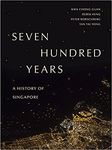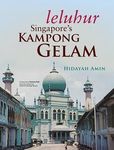Annex - National University of Singapore
←
→
Page content transcription
If your browser does not render page correctly, please read the page content below
Annex Jeremy Tiang, State of Emergency (Epigram Books, 2017) Siew Li leaves her husband and children in Tiong Bahru to fight for freedom in the jungles of Malaya. Decades later, a Malaysian journalist returns to her homeland to uncover the truth of a massacre committed during the Emergency. And in Singapore, Siew Li’s niece Stella finds herself accused of being a Marxist conspirator. Jeremy Tiang’s debut novel dives into the tumultuous days of leftist movements and political detentions in Singapore and Malaysia. It follows an extended family from the 1940s to the present day as they navigate the choppy political currents of the region. What happens when the things that divide us also bind us together? Hidayah Amin, Leluhur: Singapore’s Kampong Gelam (Helang Books, 2019) The story of Kampong Gelam – a cosmopolitan village named after the Gelam (Kayu putih or Melaleuca cajuputi) tree which once grew in abundance in the area – was birthed some two centuries ago. It began with the signing of a treaty between Sultan Hussein Mohamed Shah, Temenggong Abdul Rahman and Sir Stamford Raffles of the East India Company, whereby Sir Stamford Raffles was given permission to set up a trading post in Singapore. Although the beginnings of Singapura could be traced to a much earlier time, the historic treaty was instrumental in propelling the Lion City into prominence in the Southeast Asian region, and later the world. Once the centre of trade and commerce connecting Singapore to the rest of the Malay Archipelago, Kampong Gelam served as a religious, intellectual and social hub for the Malays in Singapore. It also functioned as a Pilgrim Hub for would-be pilgrims bound for Saudi Arabia. In 1989, the Singapore government gazetted Kampong Gelam and accorded it the status of a conservation area. A popular tourist attraction as it may be, Kampong Gelam’s rich history and heritage nevertheless extend well beyond the descriptions found in glossy tourism publicity blitz. More importantly, at the heart of it all, Kampong Gelam was home to modern Singapore’s pioneers, entrepreneurs, craftsmen and residents including the author, Hidayah, who was born in Gedung Kuning (Yellow Mansion).
To embrace the authentic spirit of Kampong Gelam, you are invited to embark on a journey to Leluhur, returning to the land of our Ancestors. Timothy P Barnard, Imperial Creatures: Humans and Other Animals in Colonial Singapore, 1819-1942 (NUS Press, 2019) The environmental turn in the humanities and social sciences has meant a new focus on the history of animals. This is one of the first books to look across species at animals in a colonial, urban society. If imperialism is a series of power relationships, it involves not only the subjugation of human communities but also animals. What was the relationship between these two processes in colonial Singapore? How did various interactions with animals enable changes in interactions between people, and the expression of power in human terms? The imposition of imperial power relationships was a process that was often complex and messy, and it led to the creation of new communities throughout the world, including the colonial port city of Singapore. Through a multidisciplinary consideration of fauna, this book weaves together a series of tales to document how animals were cherished, slaughtered, monitored and employed in a colonial society, to provide insight into how imperial rule was imposed on an island in Southeast Asia. Fauna and their histories of interacting with humans, thus, become useful tools for understanding our past, revealing the effects of establishing a colony on the biodiversity of a region, and the institutions that quickly transformed it. All animals, including humans, have been creatures of imperialism in Singapore. Their stories teach us lessons about the structures that upheld such a society and how it developed over time. Kwa Chong Guan, Tan Tai Yong, Peter Borschberg, Derek Heng, Seven Hundred Years: A History of Singapore (Marshall Cavendish Edition and National Library Board, Singapore, 2019) Assessments of Singapore’s history invariably revolve around Sir Stamford Raffles’ arrival in 1819. Before this date – we’ve been told – “nothing very much appears to have happened in Singapore”. Pre-1819 Singapore was a sleepy, historically insignificant fishing village, little more than the “occasional resort of pirates”. This ambitious book, co-written by four of Singapore’s foremost historians, offers an assertive re-evaluation of that view, firmly situating Singapore’s starting point seven hundred years ago. Drawing on a multi-disciplinary range of archival, textual and cartographical records, as well as the latest archaeological discoveries, the authors cast a
singular historical trajectory for Singapore over the past seven centuries, animating its history like never before. Written in a compelling and accessible manner, and richly illustrated with more than 200 artefacts, photographs, maps, art works and ephemera, this volume builds upon the foundations of an earlier book, Singapore: A 700-Year History. Extensively rewritten to incorporate ground- breaking research findings, Seven Hundred Years: A History of Singapore widens the historical lens and offers a vital new perspective on the story of Singapore. Kamaladevi Aravindan, Sembawang: A Novel (Singapore: Marshall Cavendish, 2020) Singapore, 1960s: Sembawang is home away from home for a tightly-knit community of bachelors and families who work at Her Majesty’s Naval Base. Behind closed doors, a matriarch controls her daughters- in-law’s movements. A bachelor from Kerala pines by his window for his forbidden lover. A maid from a rubber estate across the border aches to hold her young son once more. An inter-racial love between a conservative Tamil woman and a worldly Chinese man wreaks havoc in the life of an innocent bystander. The idyllic village life is shaken when two midwives are viciously attacked at the maternity clinic, and again when one of their own beloved residents meets with an unnatural death. As catastrophes strike, the village comes together as one. A dramatic, sweeping saga of Sembawang families across five decades. Wang Gungwu with Margaret Wang, Home is Where We Are (NUS Press, 2020) Does home have to be a country or a city?... Or is home this house or that? We have been fortunate.... We seemed always to have been home. Wang Gungwu’s account of his university education in Singapore and the UK, and the early years of his career as an academic in Malaysia capture the excitement, the ambition and the choices of a generation that saw it their responsibility to build the new nations of Southeast Asia. The exploration of the emotional and intellectual journey towards the formation of an identity, treasured by readers of Wang's Home is Not Here, extends in this volume into an appreciation of love, family life, and the life of the mind. We also see these years from Margaret’s perspective, her own fascinating family story, and her early impressions of this young bearded poet. Wise and moving, this is a
fascinating reflection on identity and belonging, and on the ability of the individual to find a place amidst the historical currents that have shaped Asia.
You can also read























































